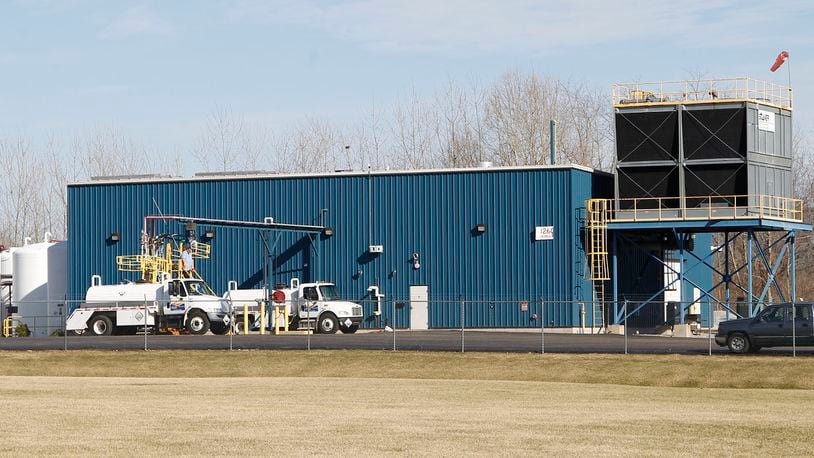The placards serve as a visible reminder that the one-ton cylinders of chlorine tucked into cheery bright blue secondary containers are deadly dangerous.
The key to protecting the workers and public is an aggressive safety protocol that includes “countless redundant safety mechanisms,” said Chris Moore, Springfield city service director. As an additional safety measure, Moore asked the newspaper not to reveal too many details, but he said the plant’s safety system includes the sealed secondary container, sensors and alarms and smearing fittings with special yellow paint that turns bright red if any chlorine escapes.
“I feel very comfortable with the security and safety mechanisms we have in place,” Moore said.
While it would be safer to sanitize water using concentrated chlorine bleach, which isn’t as dangerous, Plant Superintendent Allen Jones said a switch would be more costly.
RELATED: Toxic chemical risks hidden from public
The plant is one of 60 facilities in nine area counties with quantities of toxic or flammable chemicals that are so hazardous Risk Management Plans (RMP) must be filed with the U.S. Environmental Protection Agency every five years.
Those reports outline risk factors, safety measures and worst-case scenarios. Emergency planners and first responders can use them in training scenarios or in responding to actual accidents.
An extra level of scrutiny — and limits on chemicals — apply to companies located above the two well fields serving Dayton and its suburbs. Those additional regulations, known as Source Water Protection Area rules, were adopted after the 1987 Sherwin-Williams warehouse fire that threatened drinking water supplies, said Michele Simmons, Dayton’s environmental manager.
The two most prominent industrial accidents that occurred in recent years were in Montgomery County and involved companies that were not required to file risk management plans.
RELATED: When hazardous materials are released: Serious incidents
In 2009, a flammable vapor leak at the Veolia Environmental Services organic waste recycling plant caused a fire and multiple explosions. Four workers were injured, two severely, and businesses and houses in the neighborhood were damaged, as was every structure on the site. The company has since rebuilt.
“It’s a brand new facility with state-of-the-art safety systems to ensure that our employees and community are safe,” said Derek Bedle, general manager.
In 2003, one worker was injured and 2,000 Miami Twp. residents were evacuated after a nitric oxide explosion damaged the Isotec chemical plant. Nitric oxide is an RMP chemical but the company had too little on hand to require reporting, said Denny Bristow, coordinator of the Dayton Regional Hazardous Materials Team.
Nitric oxide is no longer used and the company has “continuously” improved its procedures since, said Jen McMahon, spokeswoman for the company, which is now called Sigma-Aldrich.
Six area RMP companies have reported accidents since 2008, but none involved major releases or multiple injuries. Statewide, 35 RMP companies have reported releases since 2008, according to the Ohio EPA.
Univar USA Inc. of West Chester has had three accidents since 2008, all chlorine releases of 500 pounds or less and blamed on equipment failure. One person was injured.
Univar is a chemical company with four RMP chemicals, including chlorine. According to Univar’s RMP worst-case scenario, a release of a 180,000-pound cylinder of chlorine could impact 995,424 people in a 14-mile radius. Univar did not respond to requests for comment.
RELATED: Highways account for vast majority of serious spills
Multiple farming cooperatives in the area have tanks of anhydrous ammonia used as fertilizer by farmers, including Trupointe Cooperative, which operates three local facilities stocking the material. The Trupoint facility in Medway had two releases since 2008 when thieves attempted to steal the chemical, likely to make methamphetamine.
Officials said those types of thefts have declined as meth makers find new ingredients. But Brad Dinnen, operations manager for Trupointe Cooperative’s South Charleston and Medway facilities, says that hasn’t lessened the company’s commitment to safety and security. The company stores anhydrous ammonia at a distance from other facilities and security measures are taken to keep people from getting to it, he said.
“I feel safe working around it,” Dinnen said.
Preventing accidents starts on the front end with thorough planning and multiple safeguards, said Simmons, the Dayton environmental manager.
“It’s always much more expensive to clean something up after an event than to prevent it,” she said.
About the Author
